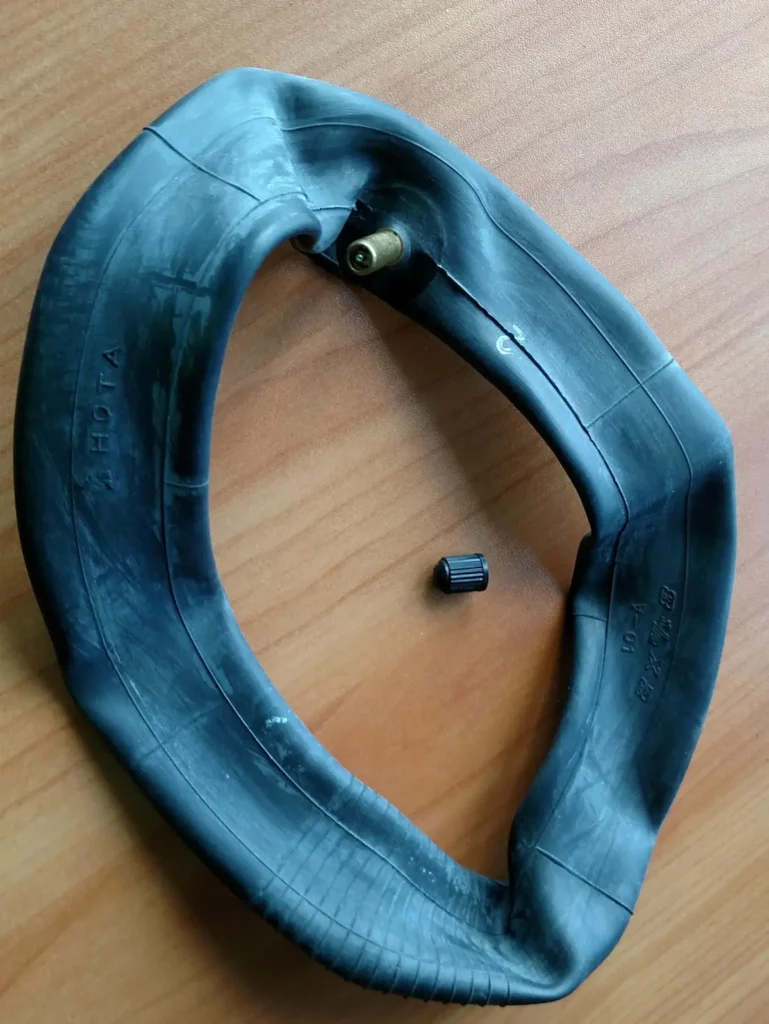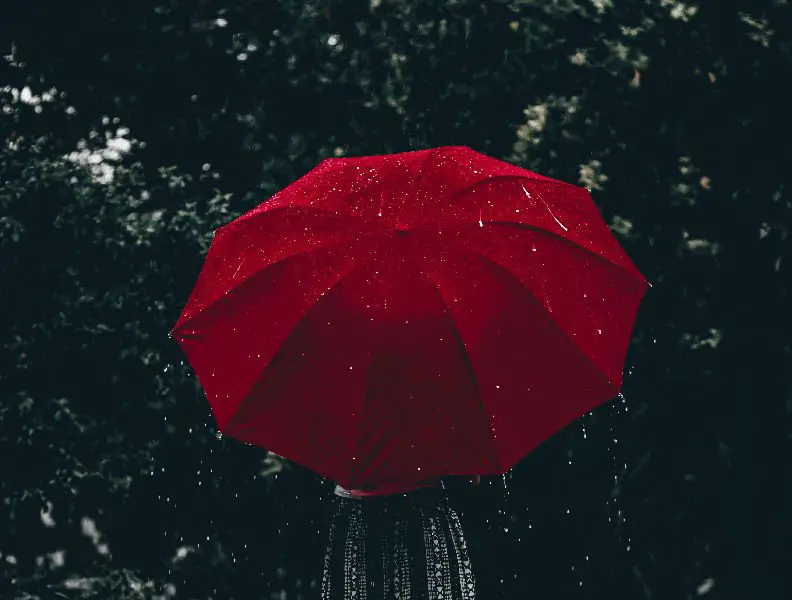Solid and pneumatic tire scooters both have their unique characteristics, offering riders a choice between durability and comfort.

Solid vs pneumatic tires in electric scooters
Pneumatic tires are usually a better choice than solid tires for electric scooters. Pneumatic tires provide more comfort, more stability, better suspension, better climbing, faster speeds, more traction, and better control. The only advantages of solid tires are not getting flat tires and less maintenance. Only choose solid tires if you live in a place with poor roads, where you may get a lot of flats.
If you are considering buying an electric scooter, the tire type will be one of the most important decisions you make. Read on to find out exactly what would be best for your situation and how to decide.

What are pneumatic tires for electric scooters?
Pneumatic, or air-filled tires, are usually made out of rubber and are filled with air.
When the tire has higher air pressure (meaning it’s more inflated), it will be harder and will not change its shape so easily. This will result in lower levels of friction against the road. As a result, the scooter will be able to move faster and climb hills better.
However, lower friction will also mean that braking will take longer. The tires will be more slippery. That’s why I and many other electric scooter owners frequently deflate our tires a bit when riding in the winter and in wet periods.
Also, since the tires will be harder, shock absorption will be lower. Therefore, the rides can be bumpier and shakier.

Checking the air pressure of your tires will be a regular part of your maintenance routine.
Check the manual that came with your scooter for the recommended tire pressure and always stick to it as closely as possible.
Air pressure is measured in mass over area. Something like “kPa” (kilo-Pascals) or “PSI” (pounds per square inch) will be the measurement unit that expresses it, but sometimes a unit like Bars is used too (see the tire pressure converter if you need to convert between them).
Use a tire pressure gauge to measure it.

Pneumatic tires will have a valve that is used to inflate or deflate the tire. The valves are usually on the inner side of the tire.
There are two different types of air-filled tires: inner-tube and tubeless pneumatic tires.
Pneumatic inner tube tires

In pneumatic tires with an inner tube, the inner tube is the actual hero of the ride. It is the container for the air of the tire – the outer tire can often get punctured without any visible consequences.
If you get a flat tire on a tire with an inner tube, you will usually have to fix or replace the inner tube itself.
Flats are more common on tires with inner tubes. The reasons for it can be a puncture, an unsuited tire fitting, or friction between the inner and outer tire.
Inner tires go around the entire perimeter of the rim of the wheel, which results in a more rudimentary design and performance.
However, it also means that maintenance is easier. You don’t need special equipment to replace your tires.
Tires with inner tubes are a more old-school solution, but they are still very common today, especially in electric scooters.
Pneumatic tubeless tires

Tubeless tires, although not common on electric scooters, are a modern approach widely used in vehicles like cars.
They contain air between the tire and the wheel, sealed to form a vacuum. If you experience a flat with a tubeless tire, a repair shop visit is typically necessary.
Tubeless tires eliminate the inner tube, reducing the chance of a breakdown, as inner tubes are the most common part to fail in traditional tires, and a punctured tubeless tire releases air slowly, preventing sudden deflation.
Pros and cons of pneumatic tires
In the world of electric scooters, the use of pneumatic tires comes with its own set of advantages and disadvantages.
Here’s a closer look at the pros and cons of using pneumatic tires on electric scooters.
- Better shock absorption
- Better traction
- Control over your rides
- Better for off-road
- Flat tires
- Maintenance
Pros of pneumatic tires
Let’s see the benefits of pneumatic tires on electric scooters and how they enhance your overall riding experience.
Pneumatic tires provide better shock absorption
The air in the tire has a suspension effect. When going over uneven terrain, you will not feel the shock as much. This is one of the biggest and most important advantages of air-filled tires, and it is what makes the occasional flat worth the effort.
Pneumatic tires have better traction

When you ride your scooter, the pressure from your weight deforms the tire and flattens it. That way, more of its surface touches the road, providing better traction. This is important for braking and overall control over your electric scooter, making your scooter less susceptible to slipping.
You can increase this effect even more if you deflate your tires a bit.
Pneumatic tires give you more control over your rides
Easily inflate or deflate your tires as you need, this advantage provides you with an interesting range of possibilities.
Inflating your tires more will result in gaining some speed, improving the climbing abilities of your scooter, and making it more efficient in its power use in general. This will also result in longer battery life and longer range as well.
Deflating your tires will take away some of those advantages. In return, it will provide you with more comfortable rides with less vibration, better control, easier steering, and most importantly, no slipping and sliding when going over wet or icy terrain.
Pneumatic tires are better for off-road
I don’t remember hearing of an off-road scooter with solid tires. All of the famous and tried-and-tested off-roaders come with pneumatic tires.
The reasons for that are simple – solid tires are too slippery and have very little traction to be used in rough terrain, and they provide almost no suspension on their own. That’s why air-filled tires are the norm for off-road scooters.
Cons of pneumatic tires
Naturally, it can’t be all good news. Pneumatic tires have very few but very important disadvantages you need to be aware of when deciding on your scooter.
Flat tires

Unfortunately, flat tires are a reality that can happen at any time.
With the increasing popularity of electric scooters, improvements, including better tire designs, have become more common. While flat tire issues are less frequent, they can still occur, causing inconveniences.
Fortunately, most flats are repairable by yourself, except for the less common tubeless tires, which may require a professional repair shop visit.
Pneumatic tire maintenance
Check the air pressure in your tires with a gauge at least once a month at the very minimum.
If you are in a hurry, an old-school kick in the tire can suffice.
What are solid tires for electric scooters?

As the name suggests, solid tires are entirely made out of solid materials and they don’t have air inside of them. Commonly, they’re made out of either rubber or silicone, but lately, we’re seeing other emerging materials as well.
Scooters with solid tires don’t suffer from flats. That’s their biggest selling point and probably the only big advantage they have.
They also require almost no care at all.
Since the tires are very hard, the tradeoff will be less stable, shakier, and more vibrating rides.
I’ve only tried riding an electric scooter with solid tires once. Everything other than the flattest of roads made the scooter shake quite a lot.

Because of that, it is common for scooters with solid tires to come with suspension.
There are three main types of solid tires:
- fully solid tires
- foam-filled tires
- honeycomb tires
Fully solid tires
The most common type of solid tire is a simple fully solid tire made out of rubber or silicone. It is the most low-tech type of tire from this entire list, and that’s the reason why it’s usually the cheapest option.
It is also the hardest tire out of all of the tires, resulting in the least stable rides of all. In addition, fully solid tires tend to get worn out the fastest because of their sturdy design.
Foam-filled tires

Foam-filled tires offer a compromise between solid and pneumatic tires, reducing the shaking and instability of solid tires while providing a more comfortable ride.
However, they require periodic foam refills, incurring additional costs.
Honeycomb tires

Honeycomb tires are another clever approach for reducing the shakiness of solid tires.
They are basically like Swiss cheese. They are usually made out of rubber or silicone as well, but they contain air pockets in them. This provides a greater level of shock absorption.
Their biggest drawback is that honeycomb tires will often be more expensive.
Pros and cons of solid tires
Let’s see the benefits and trade-offs associated with solid tires.
- No flats
- Cheaper (usually)
- Less maintenance
- Bumpier rides
- More slippery
- Can wear off faster
Pros of solid tires
Here’s a list of the pros of solid tires for electric scooters.
Solid tires don’t suffer from flats
The biggest, most important advantage that solid tires have is that it is impossible for them to get punctured and go flat.
Flats in pneumatic tires, for the most part, are not really that common. When they do happen, they are not much more than a minor annoyance.
Solid tires can be cheaper
This goes mostly for fully solid tires. They are the simplest technology of all the tire types, and also the easiest to manufacture.
You will need to refill foam-filled tires with foam. That will be a recurring expense. Honeycomb tires have no additional expenses, but they are more expensive from the start.
Solid tires require less maintenance
We might even say that solid tires require no maintenance (with the exception of foam-filled tires). As long as the wheel is fine and everything is properly adjusted, there’s not much you need to maintain. The only thing you need to be mindful of is damage from wear and tear.
Solid tires cons

The advantages of solid tires come at a steep price in my opinion. They have a few cons that make them a dealbreaker for many. Let’s have a look!
Solid tires result in less stable rides
The biggest drawback that comes from the increased hardness of solid tires is that they will always have unstable, vibrating, shaky rides.
With air-filled tires, the shock gets absorbed by the wheel for the most part. You don’t get that benefit with solid tires. That’s why oftentimes these scooters must have additional shock absorbers installed as well.
Solid tires are more slippery

Solid tires have little grip, and less of their surface touches the road.
It’s not advisable to ride any scooter in the rain or in the winter, but if your scooter has air-filled tires, at least you will have some sort of a shot at getting there in one piece. With solid tires, you will really be pushing your luck.
Solid tires can wear off faster
This was rather unexpected for me. I’ve seen a lot of comments online from scooter owners that say they’ve had to completely replace their solid tires after six months or less.
The rubber simply evaporates after a while, leaving the tire thinner, damaged, and less reliable. There is a good chance that you will have to replace a solid tire a lot faster than a pneumatic one (unless you get a flat with the pneumatic one of course).
Best electric scooters with pneumatic tires
Well, this is essentially the same question as “What are the best electric scooters?”, since most scooters come with pneumatic tires.
Watch this video if you want to know how to compare pneumatic tires and solid tires for electric scooters.
Best electric scooters with solid tires
There are only a handful of electric scooters with solid tires out there, and even fewer of them would fall into the category of very good scooters.
One of the most iconic electric scooters of all time, which is also a very good scooter, comes with solid tires. That’s the Ninebot ES2 (read the full review here).
Other great scooters with solid tires include:
Also, see the guide on the best solid-tire electric scooters for a more detailed look.
Changing scooter tires can be a challenge, as most models come with a specific type of tire. While some scooters allow for tire type swaps, it’s often not advisable because it can lead to reduced comfort, performance, or safety issues. The key factor is ensuring the new tire fits your wheel correctly, but hidden complications can arise due to the scooter’s design. Experimenting is an option, but it’s generally best not to force a different tire type unless your scooter was designed to support it.
Some electric scooters feature a combination of one solid and one pneumatic tire. This mix can help distribute risks and benefits more evenly. It’s a practical choice when you frequently experience flats on one tire, allowing you to use a solid tire on that side while keeping the other pneumatic.
The more common type of tires is pneumatic ones, by a large margin. Pneumatic tires are simply better suited for most everyday scenarios.It is possible, however, that further advancements in tire technology, honeycomb or foam-filled tires, in particular, change the game and position themselves as the new normal, if they manage to provide ride comfort comparable to the one that pneumatic tires provide.
Tire size is critical for electric scooters, impacting performance. Two key dimensions are diameter and width. Larger diameter tires, often on powerful scooters, offer more torque for speed but consume more power. Wider tires provide better balance and control, ideal for off-road scooters, but can be costlier and prone to debris-caused punctures. Most scooter tires are around 2.25-2.5 inches wide with an 8.5-inch diameter, but exceptions like the Mercane Widewheel Dual have notably wider tires for improved traction and balance.
In most situations, pneumatic tires are the better choice for electric scooters. Solid tires are recommended only in rare cases. To simplify, opt for pneumatic tires unless you specifically require solid ones. Pneumatic tires are suitable for about 90% of scenarios, making them ideal for everyday commuters and hobbyists.
Solid tires become the preferred choice over pneumatic tires in one specific scenario: when the roads and conditions where you ride are so harsh that pneumatic tires would frequently result in flats. This is the primary advantage of solid tires. Consider a scooter with solid tires if you reside in an area with poor road infrastructure characterized by numerous potholes, bumps, and uneven roads, a high presence of garbage and debris, and the risk of encountering broken glass or other hard, sharp waste materials.
The lifespan of solid tires on an electric scooter can vary depending on factors such as the quality of the tires, your riding habits, and the road conditions. On average, solid tires can last anywhere from 1,000 to 2,000 miles (1,609 to 3,218 kilometers) or more.
No, solid tires do not require air. Unlike pneumatic (air-filled) tires, solid tires are made of a solid rubber or foam material. This means there is no air inside them, so you don’t need to worry about inflating or maintaining air pressure. Solid tires are puncture-proof and low-maintenance, making them a popular choice for electric scooters and other vehicles in situations where avoiding flats is crucial.







